The Complete Guide to Standalone Book Racks: Style and Use
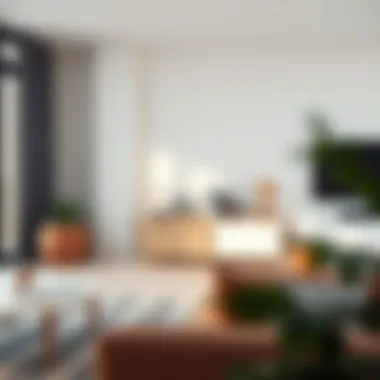
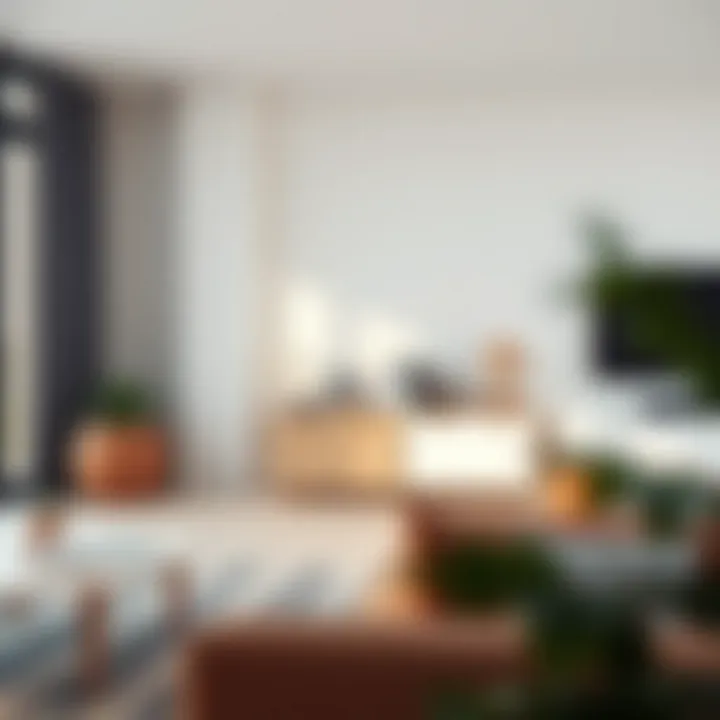
Intro
In today’s fast-paced world, the quest for both style and utility in home decor has never been more pronounced. Standalone book racks serve as a beautiful nexus between functionality and aesthetics, standing as silent yet vocal storytellers in our homes and offices. These pieces of furniture do not merely serve the purpose of holding books; they metamorphose into defining elements of space, influencing the vibe of a room. With the evolution of design trends, selecting the right book rack can enhance your environment, reflecting personal taste while also embracing practicality.
Choosing a standalone book rack is more than a mere purchase decision. It’s about finding that perfect balance where shape meets function, where materials harmonize with our lifestyles, and where color palettes resonate with the overall design scheme. This guide will take you through the myriad aspects of standalone book racks, focusing on their design intricacies, functional capabilities, and the aesthetic appeal they bring into different spaces. Buckle up as we delve into the world of standalone book racks.
Furniture Design Trends
As we step into the realm of furniture design, it’s essential to recognize current trends that shape how standalone book racks are crafted and perceived.
The furniture landscape is always shifting, and staying updated allows homeowners and designers alike to make educated choices.
Trending Materials and Textures
Today’s standalone book racks are constructed using a variety of materials, each adding distinct character and durability. The popular choices are:
- Wood: Timeless and classic, wood book racks generally offer warmth and elegance. Choices like oak or walnut bring a rustic flair, while bamboo introduces an eco-friendly touch.
- Metal: Industrial designs often employ metals like steel or wrought iron, providing a chic, modern edge that can withstand significant weight.
- Glass: For a minimalist and airy effect, tempered glass racks create an unobtrusive feel. They seamlessly spotlight the books they hold without overwhelming the design.
Textures play a crucial role too. Smooth finishes convey modernity, while rough-hewn surfaces suggest a casual, lived-in feel.
Color Palettes and Styles
When it comes to standalone book racks, color is where imagination flourishes.
- Neutral Tones: Shades like white, black, or grey can offer a clean backdrop, letting the books take center stage.
- Bold Colors: More adventurous decorators might lean towards rich blues or vibrant yellows to add a cheerful pop into the space.
- Natural Finishes: Leaving wood unfinished or stained to preserve its natural beauty appeals to those who lean towards organic aesthetics.
Understanding the current palette trends can make a significant difference in ensuring that your chosen book rack complements rather than clashes with its surroundings.
"A well-placed standalone book rack can elevate the appearance of a room, making it feel intentional and curated."
Practical Tips for Furniture Selection
Choosing the right standalone book rack transcends mere aesthetics; it includes considering how it operates within your space.
Assessing Space and Functionality
Before you've even started browsing, take a moment to evaluate where the rack will sit. Is it in a cozy corner, a busy hallway, or a spacious lounge?
- Measure the Space: Knowing the dimensions ensures your book rack isn’t too big or small for the area.
- Consider the Function: Will the rack be holding not just books, but also ornaments or plants? Some designs come with multi-tiered shelves, allowing versatility.
Balancing Aesthetics with Comfort
Finally, it’s vital to unite visuals with usability. A beautiful book rack is worth little if it doesn’t fit your daily rhythm.
- Ease of Access: Ensure books stored are easily reachable, especially if they include frequently used titles.
- Personal Touches: Feel free to adorn your rack with family photographs or knick-knacks that echo your style.
In the end, a standalone book rack should not only align with aesthetic aspirations but also integrate seamlessly into the lifestyle of its users.
Intro to Standalone Book Racks
Standalone book racks serve a unique position in both functional and aesthetic aspects of interior design. These structures are not merely shelves; they embody more than just storage solutions. They offer a blend of style, organization, and accessibility, catering to a variety of spaces from cozy reading nooks to bustling offices.
Definition and Purpose
A standalone book rack is defined as a self-supporting piece of furniture designed to hold books and other reading materials. Unlike wall-mounted shelves, these racks can be moved and rearranged based on one’s needs and tastes. Their primary purpose is twofold: to provide a designated space for books and to accentuate the decor of a room.
In practical terms, standalone book racks permit optimal use of space. They come in various sizes and configurations, allowing you to choose a model that seamlessly fits into your existing layout. Whether you prefer an eye-catching centerpiece in the living room or a subtle addition to your study, there’s a style that can meet your preferences. Additionally, it can serve as a display for decorative items, helping to create a personalized environment.
Historical Evolution
The journey of the book rack has been quite fascinating. Dating back to ancient civilizations, books were often stored on shelves made from readily available materials. The first known instances of book storage date to the Egyptians, who crafted tables from wood with slight upward curls to hold scrolls. This simple design evolved significantly over centuries.
Fast forward through time, the Middle Ages saw the rise of ornate wooden structures, often embellished with carvings, reflecting status as much as functionality. During the Renaissance, with the proliferation of printed books, book racks became a common feature in homes, with designs that mirrored the styles of the period.
In the modern era, materials used and designs have expanded dramatically. From the minimalist designs of Scandinavian influence to eclectic pieces made from recycled materials, each variation reflects its time. The book rack has come a long way, adapting to advancements in design and shifts in consumer tastes. Its evolution illustrates not only a change in aesthetics but also a developing understanding of space and organization in home and office settings.
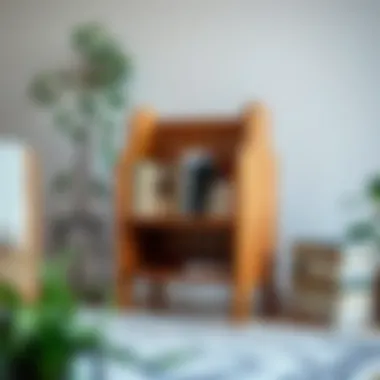
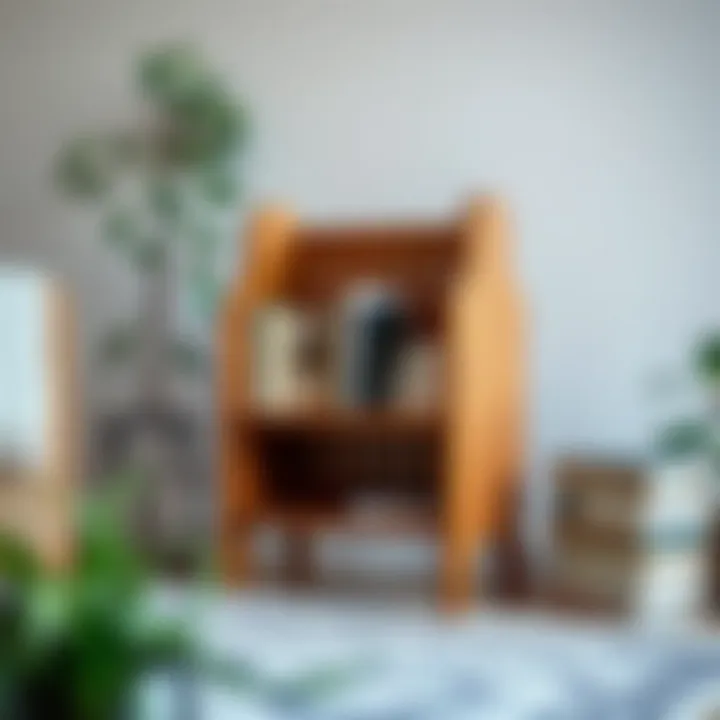
*"A well-chosen book rack can transform a plain room into a personal library, showcasing one's literary collection while enhancing interior design."
This historical context sets the stage for understanding how standalone book racks have become essential in contemporary living. The passion for reading and storing books is timeless, but the ways in which we showcase our favorites have remarkably transformed, paving the way for innovative designs encompassing diverse materials and looks.
Design Variations of Standalone Book Racks
When it comes to standalone book racks, design variations play a pivotal role in how they function within a space. These variations are not just about aesthetics; they encompass usability, accessibility, and how well the design aligns with one’s personal style and needs. In this section, we will explore the different styles, their unique attributes, and how each type can contribute to a more organized and visually appealing environment.
Contemporary Designs
Contemporary book racks are often characterized by clean lines, innovative shapes, and a fresh approach to functionality. They tend to favor materials like metal, glass, and engineered woods. This style is particularly appealing to modern homeowners looking to integrate a sleek element into living spaces.
One common theme throughout contemporary designs is modularity. Many of these racks can be rearranged or expanded, making them incredibly versatile. They often feature open shelving systems that allow for personal items to shine through. Think about utilizing them to showcase not only books but also unique decorations or family photos—truly making a statement!
Traditional and Classic Styles
On the other hand, traditional and classic styles exude a sense of nostalgia and warmth. These racks often make use of rich woods like oak or mahogany, emphasizing craftsmanship with intricate details such as carvings and inlays. The sturdiness of these pieces provides longevity, making them cherished heirlooms.
You might find a traditional book rack that fits nicely in a library setting, offering a cozy, inviting atmosphere. It's not unusual to see these racks adorned with ornate bookends or decorative trinkets that enhance the elegance of the space.
Minimalistic Approaches
Minimalism, the art of simplicity, resonates with those who appreciate uncluttered interiors. Book racks designed with this philosophy often feature sleek forms and muted colors—think whites, blacks, or natural tones. They tend to focus on the essential function of storing books without unnecessary embellishments.
This concept can be really effective for smaller spaces. A minimalistic rack may not dominate the visual field, allowing the rest of the room to breathe. It’s all about prioritizing functionality while preserving an organized look. Such designs can make any room feel spacious and calm.
Eclectic and Artistic Options
Eclectic book racks defy standard norms, allowing homeowners to express their creativity. These designs can range from whimsical forms to bold colors, often pulling inspiration from various art movements or cultural motifs. A rack might be constructed from reclaimed materials, making each piece one-of-a-kind.
Incorporating an eclectic rack can serve as a conversation starter, turning the ordinary act of organizing books into an artistic expression. This style also intertwines perfectly with other decor, offering opportunities to harmonize or starkly contrast with furnishings to create a lively and dynamic environment.
"A standalone book rack is more than just a holder for books; it’s a reflection of personality and creativity, shaping the atmosphere of a space."
Exploring these design variations enables individuals to make informed decisions, ensuring that their book racks not only serve a practical purpose but also enhance their home’s decor. Understanding the specifics of each style is essential to select a rack that resonates with one's lifestyle and space requirements.
Materials Used in Standalone Book Racks
When it comes to standalone book racks, the materials employed play a pivotal role in determining their durability, aesthetic appeal, and overall functionality. Each material brings a unique set of characteristics that influence everything from the design to the maintenance needs of the rack. Understanding the nuances between these materials can empower homeowners, designers, and decorators to select options that not only meet their practical requirements but also enhance the beauty of their spaces. From traditional wood to innovative eco-friendly alternatives, the choice of material is fundamental in achieving the perfect balance between style and function.
Wood Types and Their Durability
Wood has long held a place of honor in furniture design, including standalone book racks. Different types of wood offer varying levels of durability and look. For example, hardwoods like oak and walnut stand out for their strength and resilience against wear. They have a natural beauty that adds warmth to any room. Yet, these woods demand more care and may be costly.
On the contrary, softer woods like pine or spruce can be more budget-friendly and lightweight but are less resistant to scratches and dents. A well-crafted pine rack can still evoke charm, especially in a rustic setting. When choosing a wood type, it’s essential to consider not just how it fits into the existing decor but also how much wear and tear it will face in daily use. The finish applied to the wood can also affect durability, adding a layer of protection against stains and moisture.
Metal Structures and Aesthetic Qualities
Metal standalone book racks are often appreciated for their modern edge and industrial flair. Most commonly made from steel or aluminum, these racks tend to be lighter yet very sturdy, making them an excellent choice for those who need portability without sacrificing strength.
Metal can come in various finishes like brushed, polished, or powder-coated, each providing a distinct look. A matte black finish, for instance, can exude sophistication, while a vibrant colored powder coat can liven up a dull corner. What stands out most is the versatility with which metal can blend into various design schemes, from minimalist to eclectic. However, metal can be prone to scratches and rust in humid conditions, so location and care must be considered when integrating these racks into a home.
Fiberboard and Its Applications
Fiberboard, commonly known as engineered wood, is increasingly popular in standalone book racks. Made from wood fibers combined with adhesives and heat, it offers an affordable and eco-friendly alternative to solid wood. High-density fiberboard (HDF) and medium-density fiberboard (MDF) are the main types used in furniture design.
One key benefit of fiberboard is its uniform surface, allowing for intricate designs and finishes that may be challenging with solid wood. This type of material is less prone to warping, making it suitable for unpredictable environments. Often painted or laminated, fiberboard racks can imitate solid wood's look while being much lighter and easier to handle. Nonetheless, they may not hold up as well against heavy loads compared to solid wood or metal options, so careful consideration of what will be stored is advisable.
Sustainable and Eco-Friendly Options
As the world becomes increasingly conscious of sustainability, eco-friendly materials are gaining traction in the world of furniture, including standalone book racks. Bamboo stands out as a prime example; it's a rapidly renewable resource that offers strength akin to hardwood while being lightweight and visually appealing.
Reclaimed wood is another sustainable option, as it repurposes material that would otherwise contribute to waste. These racks not only tell a story through their unique grain patterns but also exhibit a commitment to environmental responsibility. Meanwhile, there are also synthetic eco-friendly composites being developed which mimic natural aesthetics without the ecological footprint. Choosing a sustainable option can elevate a room's appeal, sending a message of mindful living.
"The choice of material is fundamental in achieving the perfect balance between style and function."
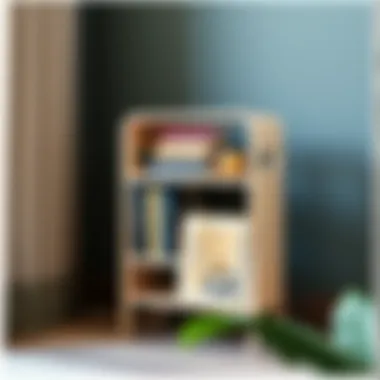
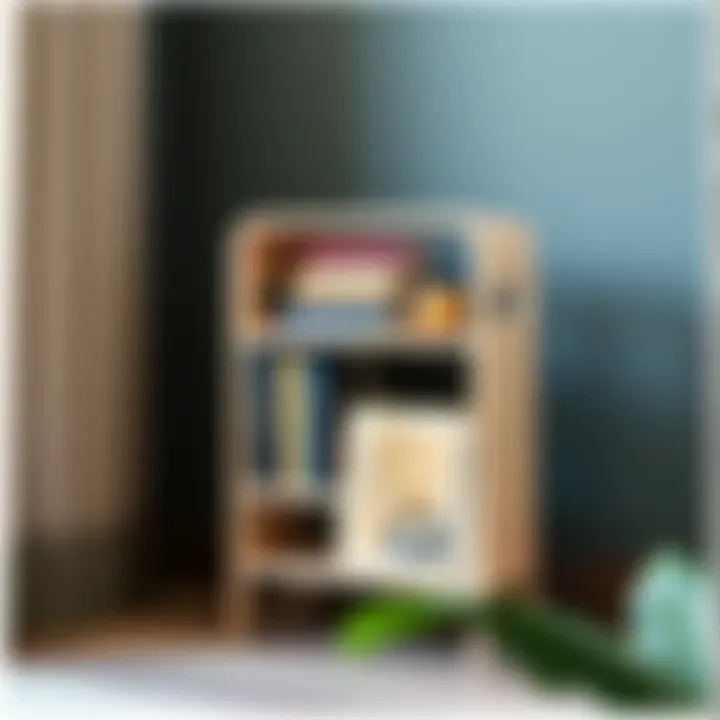
Functionality and Practical Considerations
Functionality and practical considerations hold substantial weight when it comes to standalone book racks. It’s crucial to recognize that these aren't just decorative pieces; they are fundamentally designed to serve specific purposes that align with the needs of users. Homeowners, designers, and decorators will find that emphasizing functionality ensures these racks aid in personal organization while also contributing positively to the aesthetics of a space.
Space Optimization Strategies
When choosing a standalone book rack, space optimization figures prominently. The available area in your home or office isn’t limitless, so it’s imperative to maximize every inch. Analyzing the layout can reveal opportunities that might otherwise go unnoticed. For instance, a tall, narrow book rack can fit snugly into tight corners or along cramped walls, utilizing vertical space effectively.
Color and style can also affect spatial perception. Light-colored wood or metal can give the illusion of openness, making a small area seem less cluttered. Compact designs that offer shelves or compartments can also help group books and decorative items together, freeing up additional surfaces. Don’t forget the option of corner racks, which blend seamlessly into the architecture of a room, allowing functional use of often-wasted space.
Weight Capacity and Stability Factors
Understanding the weight capacity and stability of a book rack is crucial for ensuring it stands the test of time. Not all racks are built equal; some are made to support heavier tomes while others are better suited for lighter items. It’s a common misstep to overestimate storage capabilities, leading to a precarious stack of beloved books collapsing unexpectedly.
Before making a purchase, look closely at the specifications. A sturdy frame made of high-quality materials assures not just durability, but safety as well. Moreover, the shelf design should minimize sagging over time, as this directly impacts stability. Weight distribution across the shelves also plays a role; organizing books by size and weight, with heavier items on lower shelves, can enhance overall steadiness.
Ease of Assembly and Maintenance
Lastly, consider the ease of assembly and maintenance when selecting a standalone book rack. Some furniture pieces come with intricate assembly instructions that could test anyone’s patience. A well-designed book rack will feature clear directions and not require advanced tools or expertise.
Maintenance should be straightforward as well. A rack constructed with materials that can withstand spills or dust is ideal for everyday use. Look for surfaces easy to clean and conditioned to resist scratching or staining. This ensures your rack remains as pleasing to the eye as it is functional.
"Durability, usability, and design should coexist harmoniously to ensure a book rack enhances your space without complicating it."
By zeroing in on these elements, users can effectively harmonize their functional needs with practical choices, leading to a well-arranged and visually appealing environment.
Aesthetic Appeal and Home Decor Integration
Standalone book racks do more than just hold books; they serve as an integral part of home decor, contributing to the overall aesthetic and atmosphere of a space. It's not just about functionality; homeowners often seek pieces that resonate with their design philosophies, while also enhancing the ambiance of a room. A well-chosen book rack can transform a cluttered corner into a sophisticated reading nook or brighten up an otherwise dull living room.
Color Selection and Its Impact
The color of a book rack can play a pivotal role in how it is perceived in a room. For instance, a bright red book rack can inject energy into a space, while a muted pastel blue may evoke calmness. When selecting a color, think about how it harmonizes with existing decor. Consider the following:
- Contrast: A white book rack against a dark wall can create a striking visual effect.
- Complement: Neutral tones can blend seamlessly with most furnishings, creating an elegant appearance.
- Accent: Choose colors that echo other elements in the room, like cushion covers or wall art, to tie everything together.
Evaluating color schemes is essential, as they can dramatically alter the perception and mood of your reading area.
Placement and Spatial Dynamics
How and where you position your book rack affects both its utility and how it fits within the space. An ill-placed book rack can disrupt the flow of a room. Consider these factors when determining placement:
- Accessibility: Position it within arm's reach of your favorite reading spot, perhaps near a cozy chair or sofa.
- Visibility: Make sure it's in a spot where it can be appreciated—perhaps at the end of a hallway or as a focal point in a living room.
- Balance: Avoid overcrowding; give the book rack breathing room with ample space around it to prevent a cramped feel.
Effective placement can create a natural pathway for the eye while maximizing the functionality of the space.
Incorporating Accessories and Decorative Elements
A standalone book rack becomes even more visually appealing when accessorized properly. Accessories can add personality and heighten the aesthetic value of the rack. Here are a few suggestions:
- Function Meets Style: Add decorative bookends to enhance the visual interest, while ensuring books remain organized.
- Plants: Use small potted plants, like succulents, on the top of the rack for a fresh touch of greenery.
- Artwork: Lean small pieces of art or photographs against the back of the rack to create a layered effect.
- Lighting: Consider adding a small lamp to the top of the rack for a cozy ambiance and improved reading light.
Integrating these elements not only personalizes the book rack but can also make it an eye-catching centerpiece.
Remember: The goal is to create a cohesive look that showcases your books while reflecting your unique style in your home.
By carefully considering color, placement, and accessories, one can effectively integrate standalone book racks into home decor, enhancing both functionality and aesthetic appeal. This thoughtful approach turns a simple piece of furniture into a conversation starter.
Choosing the Right Standalone Book Rack
Choosing the right standalone book rack involves understanding how this piece of furniture can enhance your space while fulfilling specific needs. The right rack doesn’t just hold books; it also reflects your style, helps in better organization, and can effectively optimize the space you have. In a world increasingly dominated by digital solutions, the charm of physical books and their dedicated spaces shouldn’t be overlooked. When it comes to selecting the perfect book rack, several factors come into play.
Assessing Your Space and Needs
Before diving into design and color preferences, it’s crucial to assess your physical space and personal requirements. Each environment presents unique challenges and opportunities when it comes to square footage. For instance, if you have a cozy reading nook in the corner of your living room, you may opt for a vertical unit that maximizes height without consuming too much floor space. Furthermore, think about what books you need to store. If it’s a modest collection of novels, a small stand with a few shelves might suffice. However, if you’re an avid reader with piles of academic texts, then a sturdier, more expansive bookshelf would be beneficial.


"The right design is never just about looks; it’s about how well it meets your living environment and reading habits."
Additionally, consider any other furniture pieces in the vicinity. A mismatched book rack can clash with your decor. Therefore, take the time to measure your space, envision how all pieces work together, and choose a book rack that ties the room together, rather than breaking it apart.
Budget Considerations and Options
When buying a standalone book rack, your budget is an important aspect. Book racks come in a spectrum of prices, influenced by the materials used, design complexity, and brand reputation. It’s essential to recognize what you are willing to invest.
- Economical Options: Brands like IKEA may offer stylish yet affordable choices for those on tight budgets.
- Mid-Range Selections: Consider local artisans or small manufacturers that can provide unique pieces without breaking the bank.
- Luxury Choices: High-end designs from brands like Restoration Hardware or Crate & Barrel reflect craftsmanship but require a significant investment.
Make sure to include additional costs when constructing your budget: shipping fees, potential assembly costs, or higher-quality care products for maintenance. Setting a clear financial limit can help streamline the selection process and ensure you're happy with the purchase decisions.
Reading Habits and Organizational Preferences
Lastly, understanding your reading habits and how you prefer to organize your books can immensely guide your choice. Clearly, not every book rack suits every reader. Do you pile books in a casual, haphazard style? Or are you the more meticulous sort who arranges them by genre, author, or color?
- Casual Readers: If you tend to read a variety of genres with no strict rule, a more eclectic, open-design book rack may suit your needs. These racks allow for creativity in how you showcase your collection.
- Organized Individuals: If organization is key for you, consider options with multiple levels or compartments. Closed shelving may also help keep dust at bay.
- Accessibility Needs: If you often need to reach for specific titles, think about height and shelf depth. An accessible unit is important for ensuriing your reading continues without hassle.
Making choices that align with your reading preferences can turn your standalone book rack into something more than just a storage unit. It can become an integral part of your space, inspiring you to dive back into the printed word.
Maintenance of Standalone Book Racks
Maintaining a standalone book rack goes beyond mere cleanliness; it protects the investment in furniture and ensures that it serves its purpose effectively over time. A well-maintained book rack not only enhances the aesthetic appeal of the space but also promotes a harmonious environment for readers. Every homeowner, designer, or decorator should consider the long-term implications of neglecting maintenance tasks. Addressing the upkeep of book racks can prevent wear, prolong the lifespan of your furniture, and keep your collection in peak condition.
Routine Cleaning Techniques
Cleaning a standalone book rack might seem like a mundane task, but routine maintenance is crucial. Dust particles and spills can accumulate over time, leading to scratches and unsightly stains. The basic steps to keep a book rack in tip-top shape include:
- Use a soft, dry cloth: Regularly dusting the surface with a microfiber cloth can avoid buildup.
- Avoid corrosive cleaners: Stick to gentle, pH-neutral cleaners for deeper cleaning, as stronger solutions might harm the finish.
- Periodic wipe-downs: Every month, a light damp cleaning with water and vinegar can refresh the surface and eliminate stubborn grime.
By establishing a simple cleaning regimen, the elegance of the book rack remains intact, showcasing the collection beautifully.
Preventing Wear and Tear
Preventive measures are vital in maintaining the integrity of your standalone book rack. Just as one wouldn’t wear the same shirt every day without taking care of it, your furniture deserves the same consideration. To minimize wear and tear, consider these tips:
- Place it away from direct sunlight: Prolonged exposure to sunlight can fade colors and warp materials.
- Use coasters or trays for items: Prevent moisture rings or scratches from even the most innocent of drinks.
- Distribute weight evenly: Overloading one side can lead to structural weakness; organize books to balance the load.
These actions don't just preserve the surface—they enhance user experience, making sure your beloved books have a safe haven.
Dealing with Damage and Repairs
Accidents happen; a book falls, or a pet might claw at the wood inadvertently. Understanding how to deal with damage can save both time and money. Depending on the severity of the damage, consider:
- Minor scratches: A dab of furniture polish or a mixture of vinegar and olive oil can mask most small scratches.
- Loose joints: If the rack’s structure begins to wobble, applying wood glue where necessary can instantly add stability.
- Replacement parts: For more significant damages, knowing where to find replacement parts for popular designs can simplify repairs significantly.
By addressing damage promptly, not only do you maintain the aesthetic value, but you also ensure that the rack continues to serve its primary function.
"A little care goes a long way; maintaining that book rack is just as important as curating its contents."
Culmination and Final Thoughts
In reflecting on the importance of standalone book racks, we recognize their dual role in both functionality and aesthetic appeal. As discussed throughout this article, these elements are critical for homeowners, designers, and decorators alike. Integrating a well-designed book rack not only provides storage but also speaks volumes about one's style and values.
Recap of Key Insights
A few salient points stand out:
- Versatile Designs: Standalone book racks come in a myriad of styles, from minimalist to eclectic, catering to various tastes and home themes.
- Material Matters: The choice of materials influences not just durability but also the rack's overall look. Wood, metal, and sustainable options each bring something unique to the table.
- Space Efficiency: Effective book rack placements can enhance room functionality while allowing for optimal organization of reading materials.
- Maintenance Importance: Understanding how to care for different materials ensures longevity and preserves the attractive elements of the rack.
These insights are particularly beneficial for individuals seeking to improve both the utility and aesthetics within their spaces.
Looking Ahead: Future Trends in Book Rack Design
As we look towards the future, it’s clear that standalone book racks are evolving.
- Smart Features: The introduction of technology into design is becoming more pronounced. Imagine book racks with integrated LED lighting or even shelves that can adjust height via smart controls.
- Customization and Modular Designs: A shift towards customizing racks according to personal space requirements is on the rise. Modular systems allow homeowners to adapt their setups as their collections grow.
- Sustainable Practices: With a greater focus on eco-friendliness, more designers are opting for sustainable materials. Biodegradable or recyclable furniture adds a layer of social responsibility.
"A home is not only a structure; it is a reflection of its inhabitants. A well-chosen book rack can encapsulate a personality, preferences, and lifestyle."
By keeping an eye on these trends, readers can better make informed choices that not only enhance their living environments but also align with contemporary values. With ongoing innovations, the future of standalone book racks appears promising, ensuring they remain relevant, practical, and stylish.



